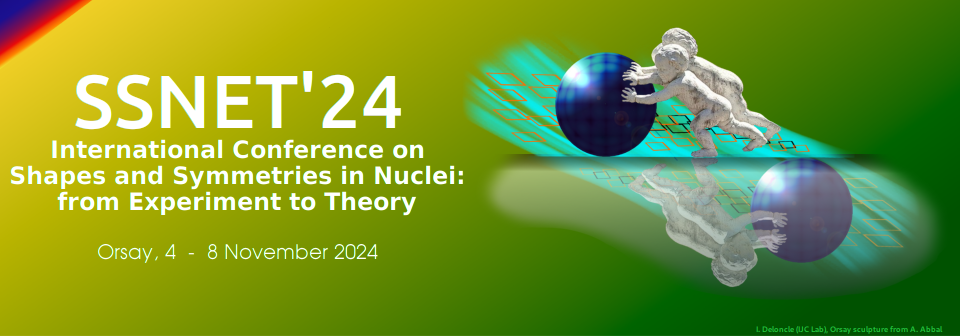Orateur
Description
In recent years there has been an increasing interest in studies of exotic nuclear shapes and underlying symmetries. Combining a realistic phenomenological mean-field approach based on an arbitrarily deformable Woods-Saxon potential, numerous large scale calculations of nuclear energies in multidimensional deformation spaces were performed indicating rich realisations of nuclear shape coexistence and shape evolution mechanisms. Combining those with powerful applied mathematics methods including inverse problem theory and graph-theory provided powerful extra tools to study both shape and symmetry properties, shape transitions, fission and and exotic fission channels such as tripartition and more.
A specially intriguing evolution was witnessed recently which follows applications of group-, and group representation theories, see especially Tagami et al., ref. [1], which allows formulating the experimental identification criteria of symmetries known in the literature as molecular symmetries traditionally applying to the distant atoms in a molecule, for instance four atoms placed at the tips of a pyramid (tetrahedral symmetry) and compact atomic nuclei bound by totally different forces.
In the present project we address similar issues, extending the strategies of the first discovery of nuclear tetrahedral and octahedral symmetries in a heavy, non-cluster nucleus $^{152}$Sm, ref. [2], to even heavier non-cluster nucleus $^{236}$U, in which we have identified, ref. [3], using experimental results from other authors, the signals of the point group symmetry C$_{\rm 2v}$ (symmetry of the water, H$_2$O, molecule). We found specific rotational structures predicted by group theory according to which C$_{\rm 2v}$ symmetry generates rotational bands composed of both odd and even spin members with both parities:
$A_1 \leftrightarrow I^{\pi}:
\,0^+, 1^-, \{2 \times 2^+, 2^-\}, \{3^+, 2 \times 3^-\},$
$\phantom{A_1 \leftrightarrow I^{\pi}:
\,}\{3 \times 4^+, 2 \times 4^-\}, \{2 \times 5^+, 3 \times 5^-\},$
$\phantom{A_1 \leftrightarrow I^{\pi}:
\,}\{4 \times 6^+, 3 \times 6^-\}, \{3 \times 7^+, 4 \times 7^-\},\; \ldots\; \leftarrow \,^{236}{\rm U} $
with degeneracies marked by curly brackets. We present mathematical details and physics discussion.
References
[1] S. Tagami, Y. R. Shimizu, and J. Dudek, Phys. Rev. C 87, 054306 (2013)
[2] J. Dudek, D. Curien, I. Dedes, K. Mazurek, S. Tagami, Y. R. Shimizu, and T. Bhattacharjee, Phys. Rev. C 97, 021302(R) (2018).
[3] I. Dedes, J. Dudek, A. Baran, D. Curien, A. Gaamouci, A. Góźdź, A. Maj, A. Pędrak, D. Rouvel, J. Yang, submitted to Phys. Rev. C

